Supply Network Design Change for Tesco PLC - Report
VerifiedAdded on 2023/05/30
|26
|7850
|438
Report
AI Summary
This report provides a detailed analysis of Tesco's international supply chain, addressing key challenges and proposing strategic solutions. It begins with an executive summary and introduction to Tesco's supply network, highlighting the need for design changes due to issues like the bullwhip effect and the limitations of current RFID technology. The report explores two supply network configurations: bullwhip reduction through the Order-Up-To policy and the implementation of advanced RFID technology for improved inventory management. It then evaluates the factors needed for adopting a response-based model, emphasizing the reduction of the bullwhip effect and improvements to the RFID system. The report also examines procurement strategies, including Tesco's lean management approach and the adoption of a pull system, cross-docking techniques, and collaborative planning, forecasting, and replenishment (CPFR). The second part of the report focuses on McDonald's case study, analyzing SCM objectives and developing an improvement strategy using the SCOR model, including a labeled diagram and discussion of cross-functional supply chain drivers. The report concludes with recommendations for Tesco's supply chain improvements.
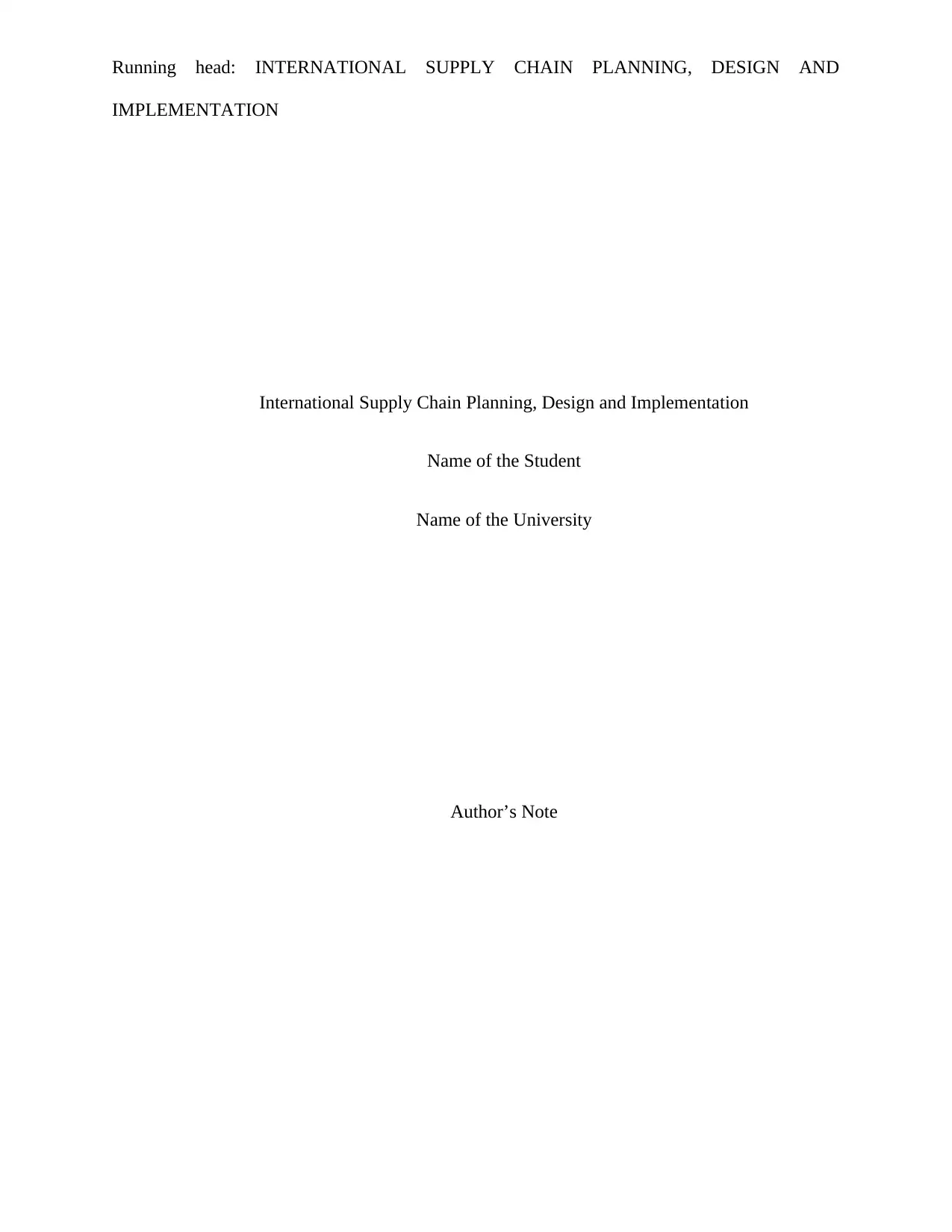
Running head: INTERNATIONAL SUPPLY CHAIN PLANNING, DESIGN AND
IMPLEMENTATION
International Supply Chain Planning, Design and Implementation
Name of the Student
Name of the University
Author’s Note
IMPLEMENTATION
International Supply Chain Planning, Design and Implementation
Name of the Student
Name of the University
Author’s Note
Paraphrase This Document
Need a fresh take? Get an instant paraphrase of this document with our AI Paraphraser
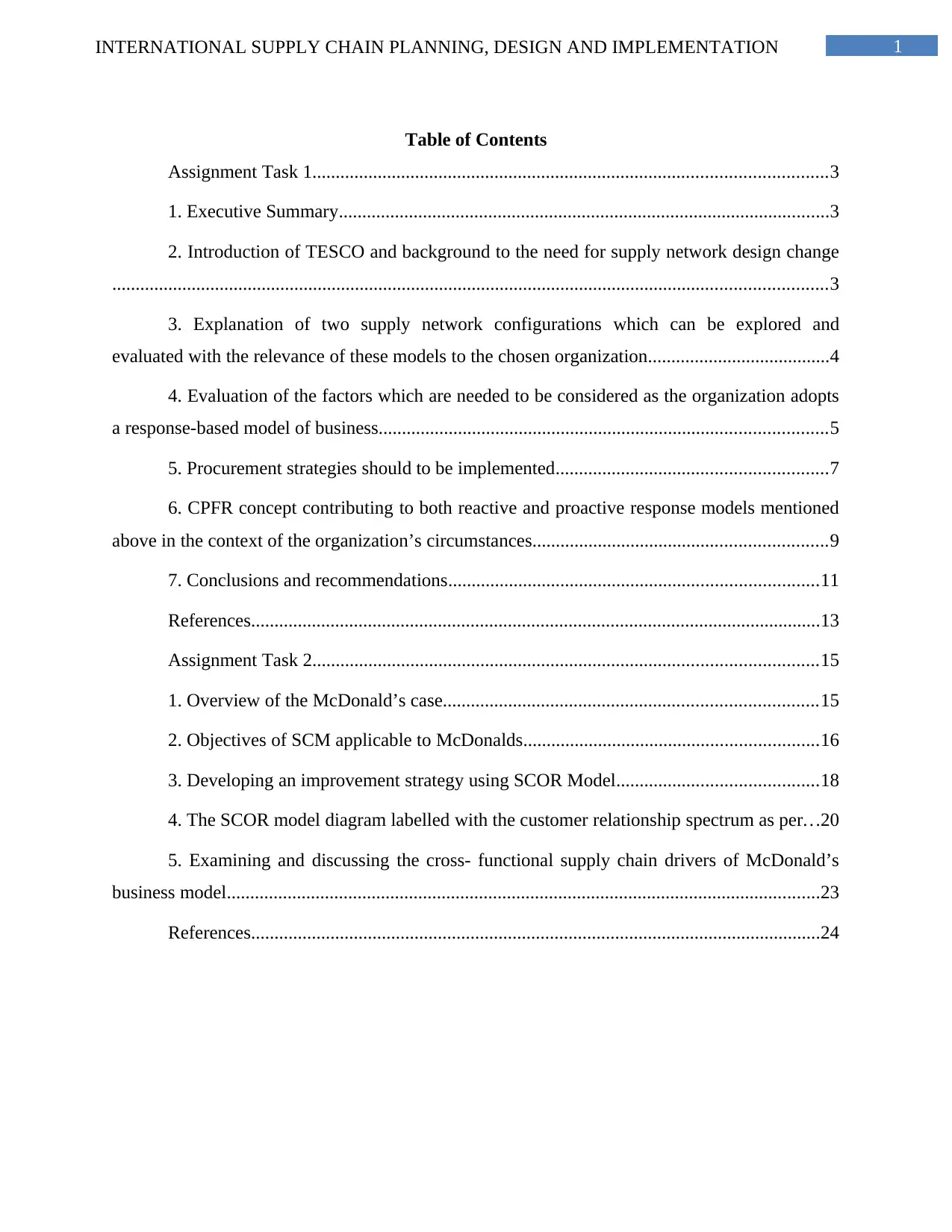
1INTERNATIONAL SUPPLY CHAIN PLANNING, DESIGN AND IMPLEMENTATION
Table of Contents
Assignment Task 1..............................................................................................................3
1. Executive Summary.........................................................................................................3
2. Introduction of TESCO and background to the need for supply network design change
.........................................................................................................................................................3
3. Explanation of two supply network configurations which can be explored and
evaluated with the relevance of these models to the chosen organization.......................................4
4. Evaluation of the factors which are needed to be considered as the organization adopts
a response-based model of business................................................................................................5
5. Procurement strategies should to be implemented..........................................................7
6. CPFR concept contributing to both reactive and proactive response models mentioned
above in the context of the organization’s circumstances...............................................................9
7. Conclusions and recommendations...............................................................................11
References..........................................................................................................................13
Assignment Task 2............................................................................................................15
1. Overview of the McDonald’s case................................................................................15
2. Objectives of SCM applicable to McDonalds...............................................................16
3. Developing an improvement strategy using SCOR Model...........................................18
4. The SCOR model diagram labelled with the customer relationship spectrum as per...20
5. Examining and discussing the cross- functional supply chain drivers of McDonald’s
business model...............................................................................................................................23
References..........................................................................................................................24
Table of Contents
Assignment Task 1..............................................................................................................3
1. Executive Summary.........................................................................................................3
2. Introduction of TESCO and background to the need for supply network design change
.........................................................................................................................................................3
3. Explanation of two supply network configurations which can be explored and
evaluated with the relevance of these models to the chosen organization.......................................4
4. Evaluation of the factors which are needed to be considered as the organization adopts
a response-based model of business................................................................................................5
5. Procurement strategies should to be implemented..........................................................7
6. CPFR concept contributing to both reactive and proactive response models mentioned
above in the context of the organization’s circumstances...............................................................9
7. Conclusions and recommendations...............................................................................11
References..........................................................................................................................13
Assignment Task 2............................................................................................................15
1. Overview of the McDonald’s case................................................................................15
2. Objectives of SCM applicable to McDonalds...............................................................16
3. Developing an improvement strategy using SCOR Model...........................................18
4. The SCOR model diagram labelled with the customer relationship spectrum as per...20
5. Examining and discussing the cross- functional supply chain drivers of McDonald’s
business model...............................................................................................................................23
References..........................................................................................................................24
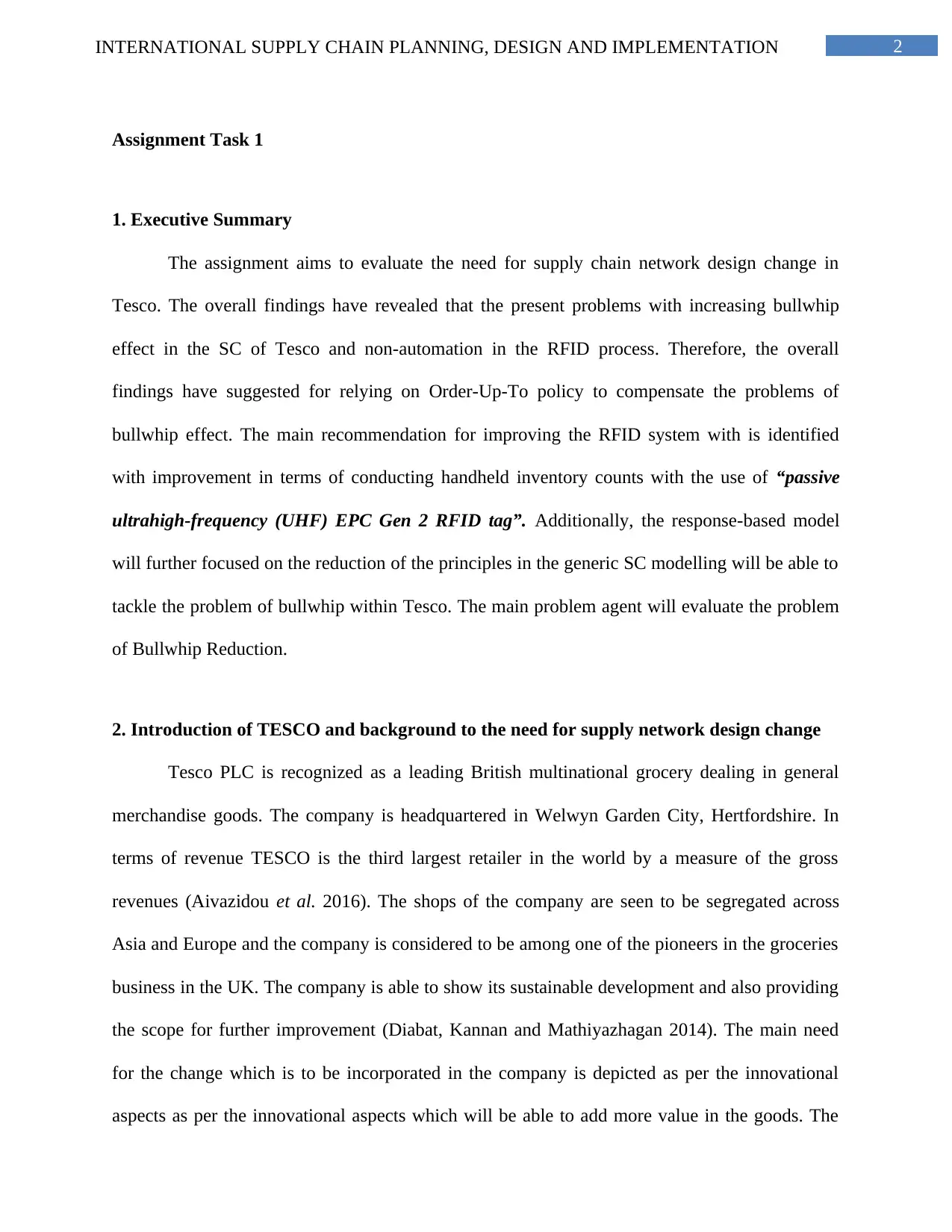
2INTERNATIONAL SUPPLY CHAIN PLANNING, DESIGN AND IMPLEMENTATION
Assignment Task 1
1. Executive Summary
The assignment aims to evaluate the need for supply chain network design change in
Tesco. The overall findings have revealed that the present problems with increasing bullwhip
effect in the SC of Tesco and non-automation in the RFID process. Therefore, the overall
findings have suggested for relying on Order-Up-To policy to compensate the problems of
bullwhip effect. The main recommendation for improving the RFID system with is identified
with improvement in terms of conducting handheld inventory counts with the use of “passive
ultrahigh-frequency (UHF) EPC Gen 2 RFID tag”. Additionally, the response-based model
will further focused on the reduction of the principles in the generic SC modelling will be able to
tackle the problem of bullwhip within Tesco. The main problem agent will evaluate the problem
of Bullwhip Reduction.
2. Introduction of TESCO and background to the need for supply network design change
Tesco PLC is recognized as a leading British multinational grocery dealing in general
merchandise goods. The company is headquartered in Welwyn Garden City, Hertfordshire. In
terms of revenue TESCO is the third largest retailer in the world by a measure of the gross
revenues (Aivazidou et al. 2016). The shops of the company are seen to be segregated across
Asia and Europe and the company is considered to be among one of the pioneers in the groceries
business in the UK. The company is able to show its sustainable development and also providing
the scope for further improvement (Diabat, Kannan and Mathiyazhagan 2014). The main need
for the change which is to be incorporated in the company is depicted as per the innovational
aspects as per the innovational aspects which will be able to add more value in the goods. The
Assignment Task 1
1. Executive Summary
The assignment aims to evaluate the need for supply chain network design change in
Tesco. The overall findings have revealed that the present problems with increasing bullwhip
effect in the SC of Tesco and non-automation in the RFID process. Therefore, the overall
findings have suggested for relying on Order-Up-To policy to compensate the problems of
bullwhip effect. The main recommendation for improving the RFID system with is identified
with improvement in terms of conducting handheld inventory counts with the use of “passive
ultrahigh-frequency (UHF) EPC Gen 2 RFID tag”. Additionally, the response-based model
will further focused on the reduction of the principles in the generic SC modelling will be able to
tackle the problem of bullwhip within Tesco. The main problem agent will evaluate the problem
of Bullwhip Reduction.
2. Introduction of TESCO and background to the need for supply network design change
Tesco PLC is recognized as a leading British multinational grocery dealing in general
merchandise goods. The company is headquartered in Welwyn Garden City, Hertfordshire. In
terms of revenue TESCO is the third largest retailer in the world by a measure of the gross
revenues (Aivazidou et al. 2016). The shops of the company are seen to be segregated across
Asia and Europe and the company is considered to be among one of the pioneers in the groceries
business in the UK. The company is able to show its sustainable development and also providing
the scope for further improvement (Diabat, Kannan and Mathiyazhagan 2014). The main need
for the change which is to be incorporated in the company is depicted as per the innovational
aspects as per the innovational aspects which will be able to add more value in the goods. The
⊘ This is a preview!⊘
Do you want full access?
Subscribe today to unlock all pages.

Trusted by 1+ million students worldwide
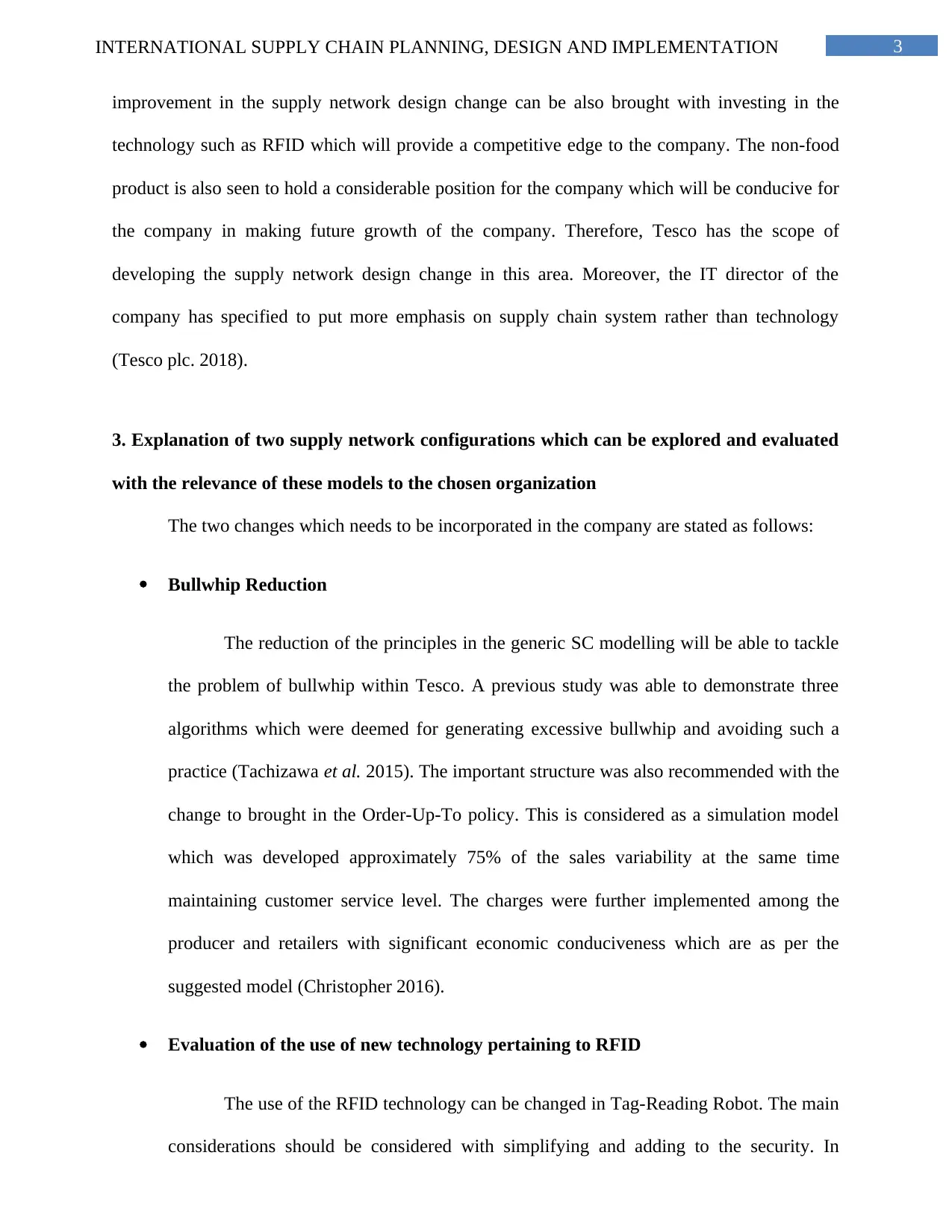
3INTERNATIONAL SUPPLY CHAIN PLANNING, DESIGN AND IMPLEMENTATION
improvement in the supply network design change can be also brought with investing in the
technology such as RFID which will provide a competitive edge to the company. The non-food
product is also seen to hold a considerable position for the company which will be conducive for
the company in making future growth of the company. Therefore, Tesco has the scope of
developing the supply network design change in this area. Moreover, the IT director of the
company has specified to put more emphasis on supply chain system rather than technology
(Tesco plc. 2018).
3. Explanation of two supply network configurations which can be explored and evaluated
with the relevance of these models to the chosen organization
The two changes which needs to be incorporated in the company are stated as follows:
Bullwhip Reduction
The reduction of the principles in the generic SC modelling will be able to tackle
the problem of bullwhip within Tesco. A previous study was able to demonstrate three
algorithms which were deemed for generating excessive bullwhip and avoiding such a
practice (Tachizawa et al. 2015). The important structure was also recommended with the
change to brought in the Order-Up-To policy. This is considered as a simulation model
which was developed approximately 75% of the sales variability at the same time
maintaining customer service level. The charges were further implemented among the
producer and retailers with significant economic conduciveness which are as per the
suggested model (Christopher 2016).
Evaluation of the use of new technology pertaining to RFID
The use of the RFID technology can be changed in Tag-Reading Robot. The main
considerations should be considered with simplifying and adding to the security. In
improvement in the supply network design change can be also brought with investing in the
technology such as RFID which will provide a competitive edge to the company. The non-food
product is also seen to hold a considerable position for the company which will be conducive for
the company in making future growth of the company. Therefore, Tesco has the scope of
developing the supply network design change in this area. Moreover, the IT director of the
company has specified to put more emphasis on supply chain system rather than technology
(Tesco plc. 2018).
3. Explanation of two supply network configurations which can be explored and evaluated
with the relevance of these models to the chosen organization
The two changes which needs to be incorporated in the company are stated as follows:
Bullwhip Reduction
The reduction of the principles in the generic SC modelling will be able to tackle
the problem of bullwhip within Tesco. A previous study was able to demonstrate three
algorithms which were deemed for generating excessive bullwhip and avoiding such a
practice (Tachizawa et al. 2015). The important structure was also recommended with the
change to brought in the Order-Up-To policy. This is considered as a simulation model
which was developed approximately 75% of the sales variability at the same time
maintaining customer service level. The charges were further implemented among the
producer and retailers with significant economic conduciveness which are as per the
suggested model (Christopher 2016).
Evaluation of the use of new technology pertaining to RFID
The use of the RFID technology can be changed in Tag-Reading Robot. The main
considerations should be considered with simplifying and adding to the security. In
Paraphrase This Document
Need a fresh take? Get an instant paraphrase of this document with our AI Paraphraser
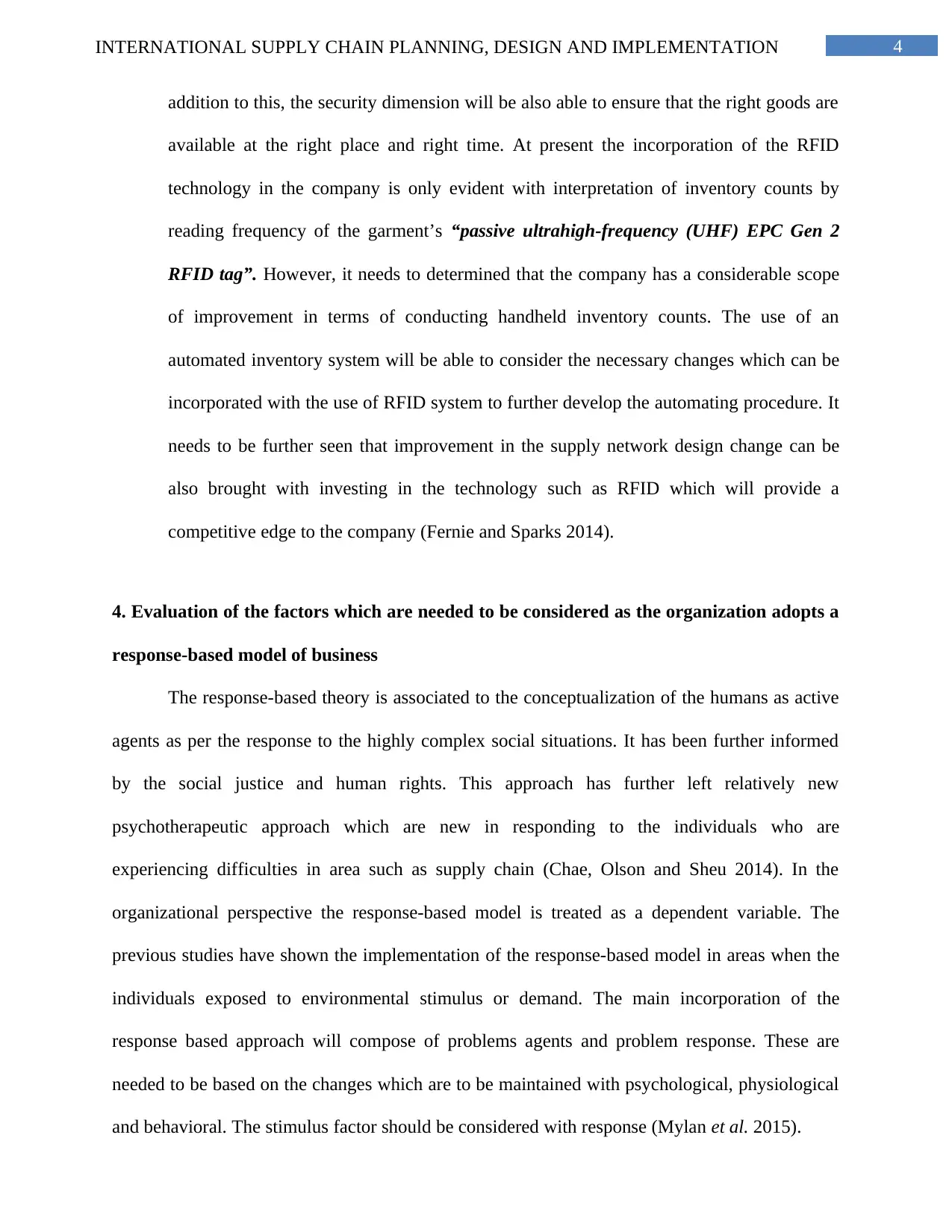
4INTERNATIONAL SUPPLY CHAIN PLANNING, DESIGN AND IMPLEMENTATION
addition to this, the security dimension will be also able to ensure that the right goods are
available at the right place and right time. At present the incorporation of the RFID
technology in the company is only evident with interpretation of inventory counts by
reading frequency of the garment’s “passive ultrahigh-frequency (UHF) EPC Gen 2
RFID tag”. However, it needs to determined that the company has a considerable scope
of improvement in terms of conducting handheld inventory counts. The use of an
automated inventory system will be able to consider the necessary changes which can be
incorporated with the use of RFID system to further develop the automating procedure. It
needs to be further seen that improvement in the supply network design change can be
also brought with investing in the technology such as RFID which will provide a
competitive edge to the company (Fernie and Sparks 2014).
4. Evaluation of the factors which are needed to be considered as the organization adopts a
response-based model of business
The response-based theory is associated to the conceptualization of the humans as active
agents as per the response to the highly complex social situations. It has been further informed
by the social justice and human rights. This approach has further left relatively new
psychotherapeutic approach which are new in responding to the individuals who are
experiencing difficulties in area such as supply chain (Chae, Olson and Sheu 2014). In the
organizational perspective the response-based model is treated as a dependent variable. The
previous studies have shown the implementation of the response-based model in areas when the
individuals exposed to environmental stimulus or demand. The main incorporation of the
response based approach will compose of problems agents and problem response. These are
needed to be based on the changes which are to be maintained with psychological, physiological
and behavioral. The stimulus factor should be considered with response (Mylan et al. 2015).
addition to this, the security dimension will be also able to ensure that the right goods are
available at the right place and right time. At present the incorporation of the RFID
technology in the company is only evident with interpretation of inventory counts by
reading frequency of the garment’s “passive ultrahigh-frequency (UHF) EPC Gen 2
RFID tag”. However, it needs to determined that the company has a considerable scope
of improvement in terms of conducting handheld inventory counts. The use of an
automated inventory system will be able to consider the necessary changes which can be
incorporated with the use of RFID system to further develop the automating procedure. It
needs to be further seen that improvement in the supply network design change can be
also brought with investing in the technology such as RFID which will provide a
competitive edge to the company (Fernie and Sparks 2014).
4. Evaluation of the factors which are needed to be considered as the organization adopts a
response-based model of business
The response-based theory is associated to the conceptualization of the humans as active
agents as per the response to the highly complex social situations. It has been further informed
by the social justice and human rights. This approach has further left relatively new
psychotherapeutic approach which are new in responding to the individuals who are
experiencing difficulties in area such as supply chain (Chae, Olson and Sheu 2014). In the
organizational perspective the response-based model is treated as a dependent variable. The
previous studies have shown the implementation of the response-based model in areas when the
individuals exposed to environmental stimulus or demand. The main incorporation of the
response based approach will compose of problems agents and problem response. These are
needed to be based on the changes which are to be maintained with psychological, physiological
and behavioral. The stimulus factor should be considered with response (Mylan et al. 2015).
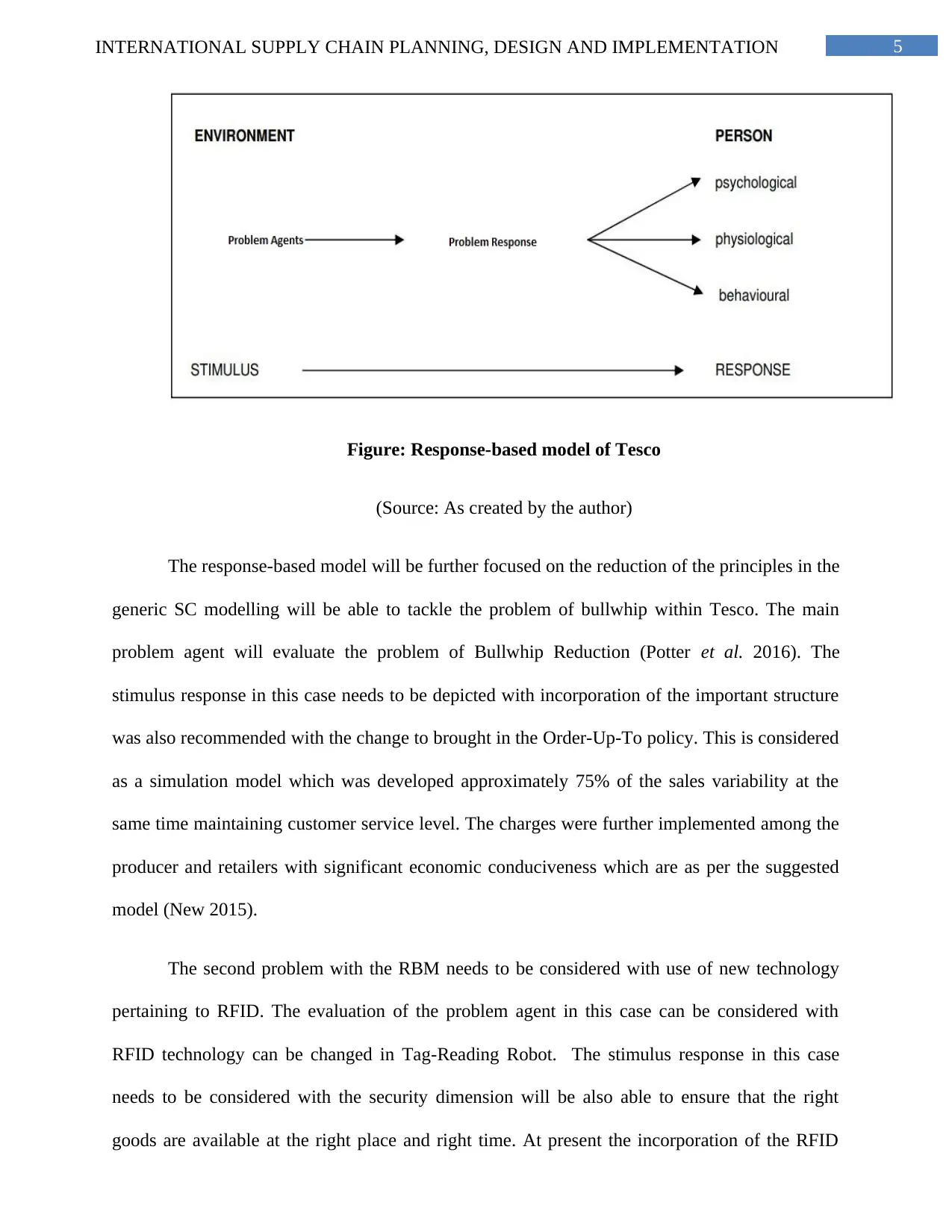
5INTERNATIONAL SUPPLY CHAIN PLANNING, DESIGN AND IMPLEMENTATION
Figure: Response-based model of Tesco
(Source: As created by the author)
The response-based model will be further focused on the reduction of the principles in the
generic SC modelling will be able to tackle the problem of bullwhip within Tesco. The main
problem agent will evaluate the problem of Bullwhip Reduction (Potter et al. 2016). The
stimulus response in this case needs to be depicted with incorporation of the important structure
was also recommended with the change to brought in the Order-Up-To policy. This is considered
as a simulation model which was developed approximately 75% of the sales variability at the
same time maintaining customer service level. The charges were further implemented among the
producer and retailers with significant economic conduciveness which are as per the suggested
model (New 2015).
The second problem with the RBM needs to be considered with use of new technology
pertaining to RFID. The evaluation of the problem agent in this case can be considered with
RFID technology can be changed in Tag-Reading Robot. The stimulus response in this case
needs to be considered with the security dimension will be also able to ensure that the right
goods are available at the right place and right time. At present the incorporation of the RFID
Figure: Response-based model of Tesco
(Source: As created by the author)
The response-based model will be further focused on the reduction of the principles in the
generic SC modelling will be able to tackle the problem of bullwhip within Tesco. The main
problem agent will evaluate the problem of Bullwhip Reduction (Potter et al. 2016). The
stimulus response in this case needs to be depicted with incorporation of the important structure
was also recommended with the change to brought in the Order-Up-To policy. This is considered
as a simulation model which was developed approximately 75% of the sales variability at the
same time maintaining customer service level. The charges were further implemented among the
producer and retailers with significant economic conduciveness which are as per the suggested
model (New 2015).
The second problem with the RBM needs to be considered with use of new technology
pertaining to RFID. The evaluation of the problem agent in this case can be considered with
RFID technology can be changed in Tag-Reading Robot. The stimulus response in this case
needs to be considered with the security dimension will be also able to ensure that the right
goods are available at the right place and right time. At present the incorporation of the RFID
⊘ This is a preview!⊘
Do you want full access?
Subscribe today to unlock all pages.

Trusted by 1+ million students worldwide
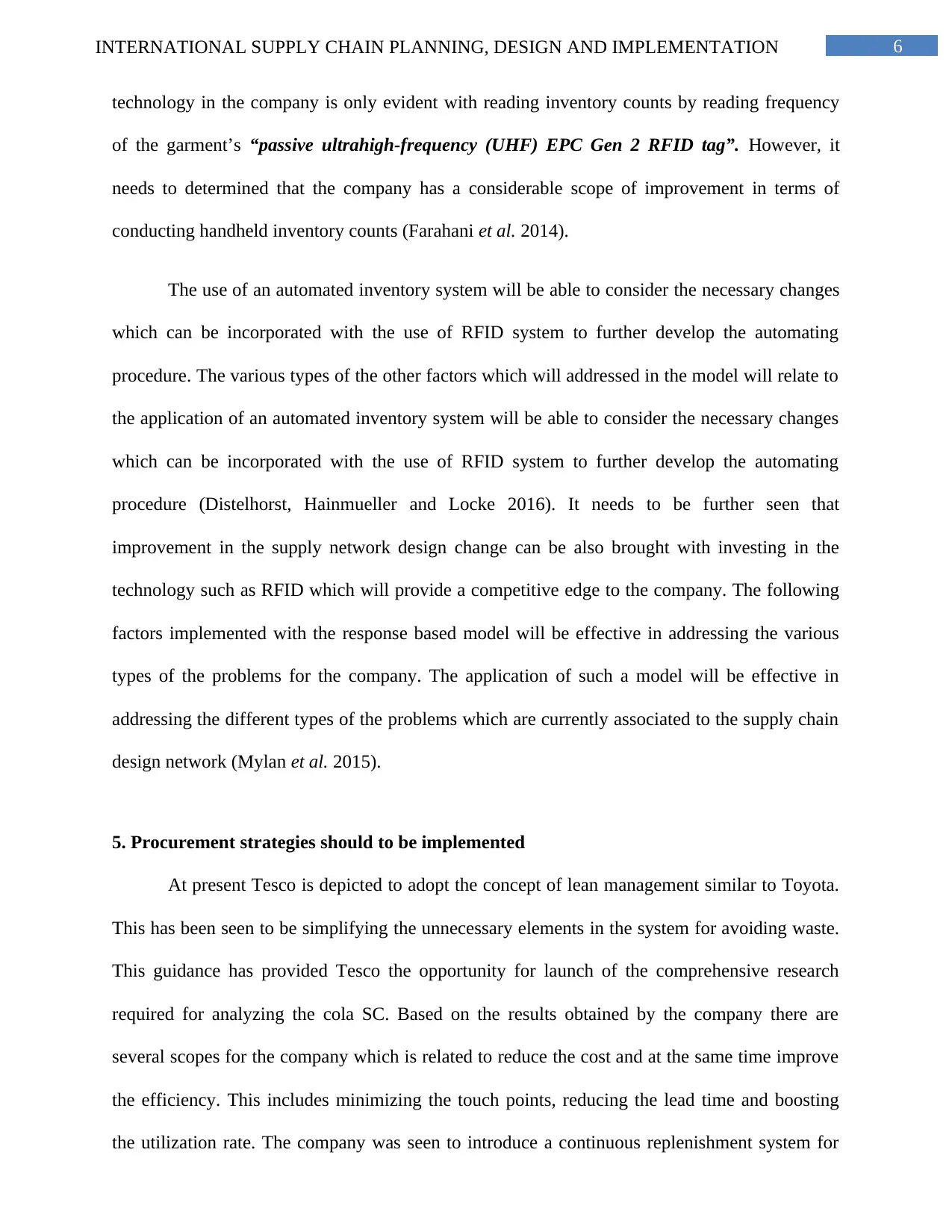
6INTERNATIONAL SUPPLY CHAIN PLANNING, DESIGN AND IMPLEMENTATION
technology in the company is only evident with reading inventory counts by reading frequency
of the garment’s “passive ultrahigh-frequency (UHF) EPC Gen 2 RFID tag”. However, it
needs to determined that the company has a considerable scope of improvement in terms of
conducting handheld inventory counts (Farahani et al. 2014).
The use of an automated inventory system will be able to consider the necessary changes
which can be incorporated with the use of RFID system to further develop the automating
procedure. The various types of the other factors which will addressed in the model will relate to
the application of an automated inventory system will be able to consider the necessary changes
which can be incorporated with the use of RFID system to further develop the automating
procedure (Distelhorst, Hainmueller and Locke 2016). It needs to be further seen that
improvement in the supply network design change can be also brought with investing in the
technology such as RFID which will provide a competitive edge to the company. The following
factors implemented with the response based model will be effective in addressing the various
types of the problems for the company. The application of such a model will be effective in
addressing the different types of the problems which are currently associated to the supply chain
design network (Mylan et al. 2015).
5. Procurement strategies should to be implemented
At present Tesco is depicted to adopt the concept of lean management similar to Toyota.
This has been seen to be simplifying the unnecessary elements in the system for avoiding waste.
This guidance has provided Tesco the opportunity for launch of the comprehensive research
required for analyzing the cola SC. Based on the results obtained by the company there are
several scopes for the company which is related to reduce the cost and at the same time improve
the efficiency. This includes minimizing the touch points, reducing the lead time and boosting
the utilization rate. The company was seen to introduce a continuous replenishment system for
technology in the company is only evident with reading inventory counts by reading frequency
of the garment’s “passive ultrahigh-frequency (UHF) EPC Gen 2 RFID tag”. However, it
needs to determined that the company has a considerable scope of improvement in terms of
conducting handheld inventory counts (Farahani et al. 2014).
The use of an automated inventory system will be able to consider the necessary changes
which can be incorporated with the use of RFID system to further develop the automating
procedure. The various types of the other factors which will addressed in the model will relate to
the application of an automated inventory system will be able to consider the necessary changes
which can be incorporated with the use of RFID system to further develop the automating
procedure (Distelhorst, Hainmueller and Locke 2016). It needs to be further seen that
improvement in the supply network design change can be also brought with investing in the
technology such as RFID which will provide a competitive edge to the company. The following
factors implemented with the response based model will be effective in addressing the various
types of the problems for the company. The application of such a model will be effective in
addressing the different types of the problems which are currently associated to the supply chain
design network (Mylan et al. 2015).
5. Procurement strategies should to be implemented
At present Tesco is depicted to adopt the concept of lean management similar to Toyota.
This has been seen to be simplifying the unnecessary elements in the system for avoiding waste.
This guidance has provided Tesco the opportunity for launch of the comprehensive research
required for analyzing the cola SC. Based on the results obtained by the company there are
several scopes for the company which is related to reduce the cost and at the same time improve
the efficiency. This includes minimizing the touch points, reducing the lead time and boosting
the utilization rate. The company was seen to introduce a continuous replenishment system for
Paraphrase This Document
Need a fresh take? Get an instant paraphrase of this document with our AI Paraphraser
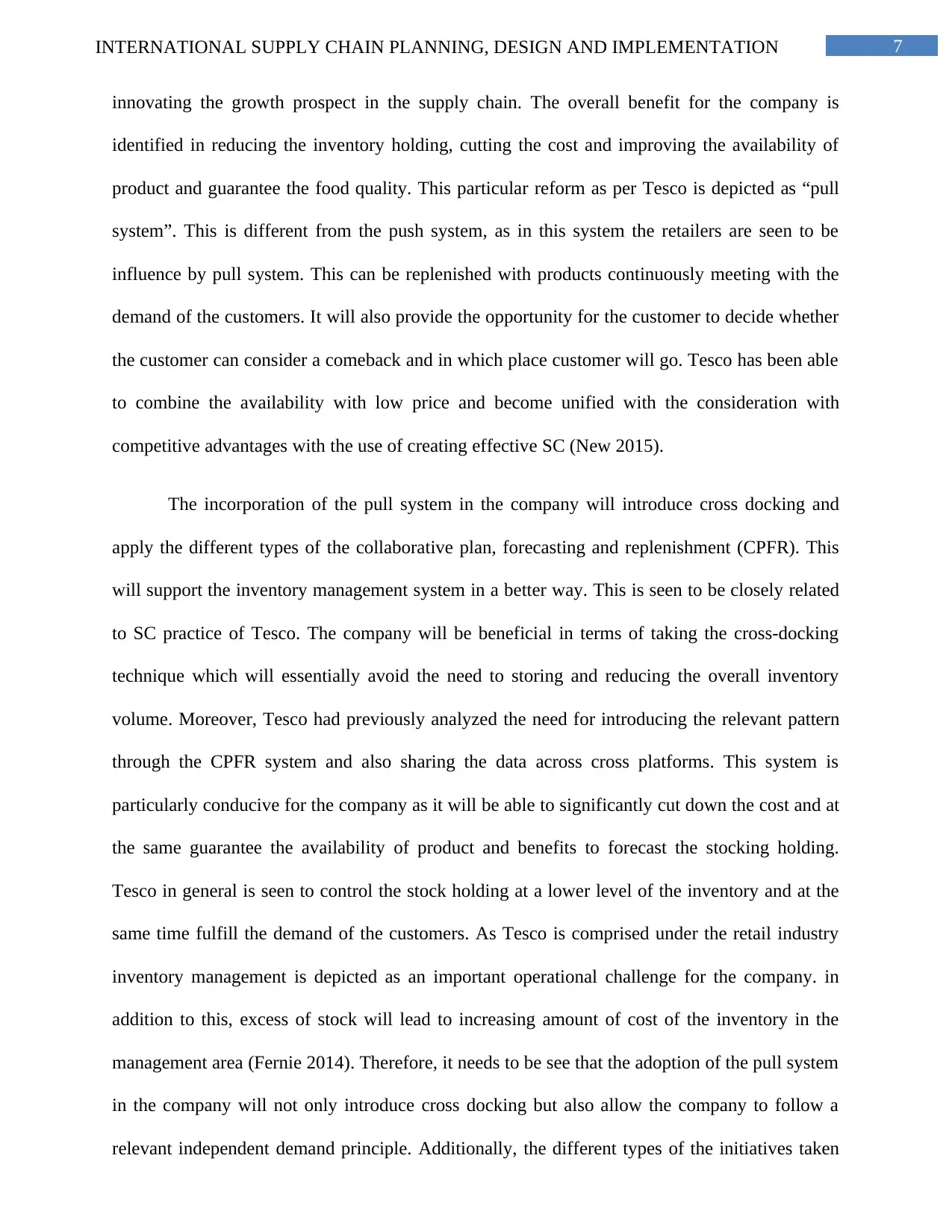
7INTERNATIONAL SUPPLY CHAIN PLANNING, DESIGN AND IMPLEMENTATION
innovating the growth prospect in the supply chain. The overall benefit for the company is
identified in reducing the inventory holding, cutting the cost and improving the availability of
product and guarantee the food quality. This particular reform as per Tesco is depicted as “pull
system”. This is different from the push system, as in this system the retailers are seen to be
influence by pull system. This can be replenished with products continuously meeting with the
demand of the customers. It will also provide the opportunity for the customer to decide whether
the customer can consider a comeback and in which place customer will go. Tesco has been able
to combine the availability with low price and become unified with the consideration with
competitive advantages with the use of creating effective SC (New 2015).
The incorporation of the pull system in the company will introduce cross docking and
apply the different types of the collaborative plan, forecasting and replenishment (CPFR). This
will support the inventory management system in a better way. This is seen to be closely related
to SC practice of Tesco. The company will be beneficial in terms of taking the cross-docking
technique which will essentially avoid the need to storing and reducing the overall inventory
volume. Moreover, Tesco had previously analyzed the need for introducing the relevant pattern
through the CPFR system and also sharing the data across cross platforms. This system is
particularly conducive for the company as it will be able to significantly cut down the cost and at
the same guarantee the availability of product and benefits to forecast the stocking holding.
Tesco in general is seen to control the stock holding at a lower level of the inventory and at the
same time fulfill the demand of the customers. As Tesco is comprised under the retail industry
inventory management is depicted as an important operational challenge for the company. in
addition to this, excess of stock will lead to increasing amount of cost of the inventory in the
management area (Fernie 2014). Therefore, it needs to be see that the adoption of the pull system
in the company will not only introduce cross docking but also allow the company to follow a
relevant independent demand principle. Additionally, the different types of the initiatives taken
innovating the growth prospect in the supply chain. The overall benefit for the company is
identified in reducing the inventory holding, cutting the cost and improving the availability of
product and guarantee the food quality. This particular reform as per Tesco is depicted as “pull
system”. This is different from the push system, as in this system the retailers are seen to be
influence by pull system. This can be replenished with products continuously meeting with the
demand of the customers. It will also provide the opportunity for the customer to decide whether
the customer can consider a comeback and in which place customer will go. Tesco has been able
to combine the availability with low price and become unified with the consideration with
competitive advantages with the use of creating effective SC (New 2015).
The incorporation of the pull system in the company will introduce cross docking and
apply the different types of the collaborative plan, forecasting and replenishment (CPFR). This
will support the inventory management system in a better way. This is seen to be closely related
to SC practice of Tesco. The company will be beneficial in terms of taking the cross-docking
technique which will essentially avoid the need to storing and reducing the overall inventory
volume. Moreover, Tesco had previously analyzed the need for introducing the relevant pattern
through the CPFR system and also sharing the data across cross platforms. This system is
particularly conducive for the company as it will be able to significantly cut down the cost and at
the same guarantee the availability of product and benefits to forecast the stocking holding.
Tesco in general is seen to control the stock holding at a lower level of the inventory and at the
same time fulfill the demand of the customers. As Tesco is comprised under the retail industry
inventory management is depicted as an important operational challenge for the company. in
addition to this, excess of stock will lead to increasing amount of cost of the inventory in the
management area (Fernie 2014). Therefore, it needs to be see that the adoption of the pull system
in the company will not only introduce cross docking but also allow the company to follow a
relevant independent demand principle. Additionally, the different types of the initiatives taken
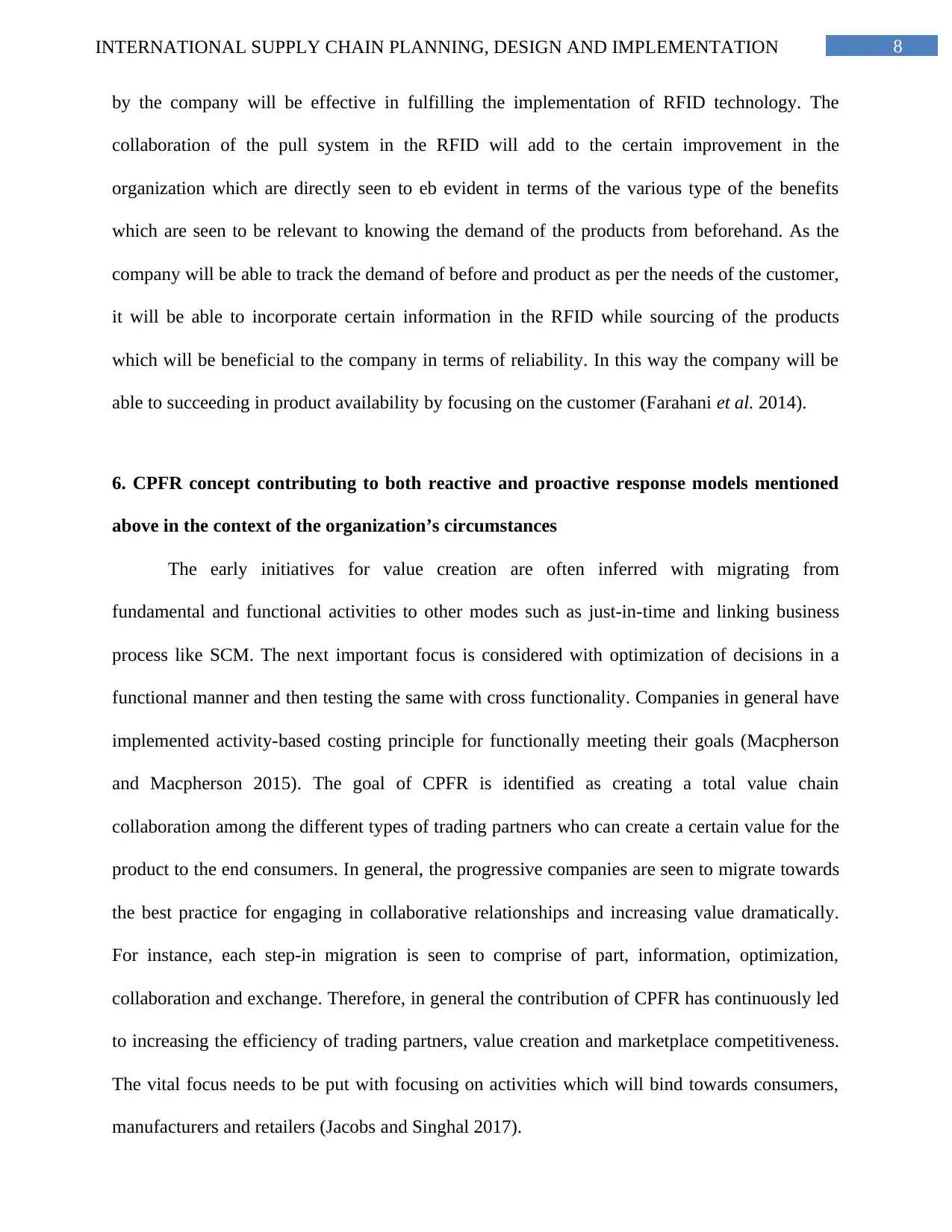
8INTERNATIONAL SUPPLY CHAIN PLANNING, DESIGN AND IMPLEMENTATION
by the company will be effective in fulfilling the implementation of RFID technology. The
collaboration of the pull system in the RFID will add to the certain improvement in the
organization which are directly seen to eb evident in terms of the various type of the benefits
which are seen to be relevant to knowing the demand of the products from beforehand. As the
company will be able to track the demand of before and product as per the needs of the customer,
it will be able to incorporate certain information in the RFID while sourcing of the products
which will be beneficial to the company in terms of reliability. In this way the company will be
able to succeeding in product availability by focusing on the customer (Farahani et al. 2014).
6. CPFR concept contributing to both reactive and proactive response models mentioned
above in the context of the organization’s circumstances
The early initiatives for value creation are often inferred with migrating from
fundamental and functional activities to other modes such as just-in-time and linking business
process like SCM. The next important focus is considered with optimization of decisions in a
functional manner and then testing the same with cross functionality. Companies in general have
implemented activity-based costing principle for functionally meeting their goals (Macpherson
and Macpherson 2015). The goal of CPFR is identified as creating a total value chain
collaboration among the different types of trading partners who can create a certain value for the
product to the end consumers. In general, the progressive companies are seen to migrate towards
the best practice for engaging in collaborative relationships and increasing value dramatically.
For instance, each step-in migration is seen to comprise of part, information, optimization,
collaboration and exchange. Therefore, in general the contribution of CPFR has continuously led
to increasing the efficiency of trading partners, value creation and marketplace competitiveness.
The vital focus needs to be put with focusing on activities which will bind towards consumers,
manufacturers and retailers (Jacobs and Singhal 2017).
by the company will be effective in fulfilling the implementation of RFID technology. The
collaboration of the pull system in the RFID will add to the certain improvement in the
organization which are directly seen to eb evident in terms of the various type of the benefits
which are seen to be relevant to knowing the demand of the products from beforehand. As the
company will be able to track the demand of before and product as per the needs of the customer,
it will be able to incorporate certain information in the RFID while sourcing of the products
which will be beneficial to the company in terms of reliability. In this way the company will be
able to succeeding in product availability by focusing on the customer (Farahani et al. 2014).
6. CPFR concept contributing to both reactive and proactive response models mentioned
above in the context of the organization’s circumstances
The early initiatives for value creation are often inferred with migrating from
fundamental and functional activities to other modes such as just-in-time and linking business
process like SCM. The next important focus is considered with optimization of decisions in a
functional manner and then testing the same with cross functionality. Companies in general have
implemented activity-based costing principle for functionally meeting their goals (Macpherson
and Macpherson 2015). The goal of CPFR is identified as creating a total value chain
collaboration among the different types of trading partners who can create a certain value for the
product to the end consumers. In general, the progressive companies are seen to migrate towards
the best practice for engaging in collaborative relationships and increasing value dramatically.
For instance, each step-in migration is seen to comprise of part, information, optimization,
collaboration and exchange. Therefore, in general the contribution of CPFR has continuously led
to increasing the efficiency of trading partners, value creation and marketplace competitiveness.
The vital focus needs to be put with focusing on activities which will bind towards consumers,
manufacturers and retailers (Jacobs and Singhal 2017).
⊘ This is a preview!⊘
Do you want full access?
Subscribe today to unlock all pages.

Trusted by 1+ million students worldwide
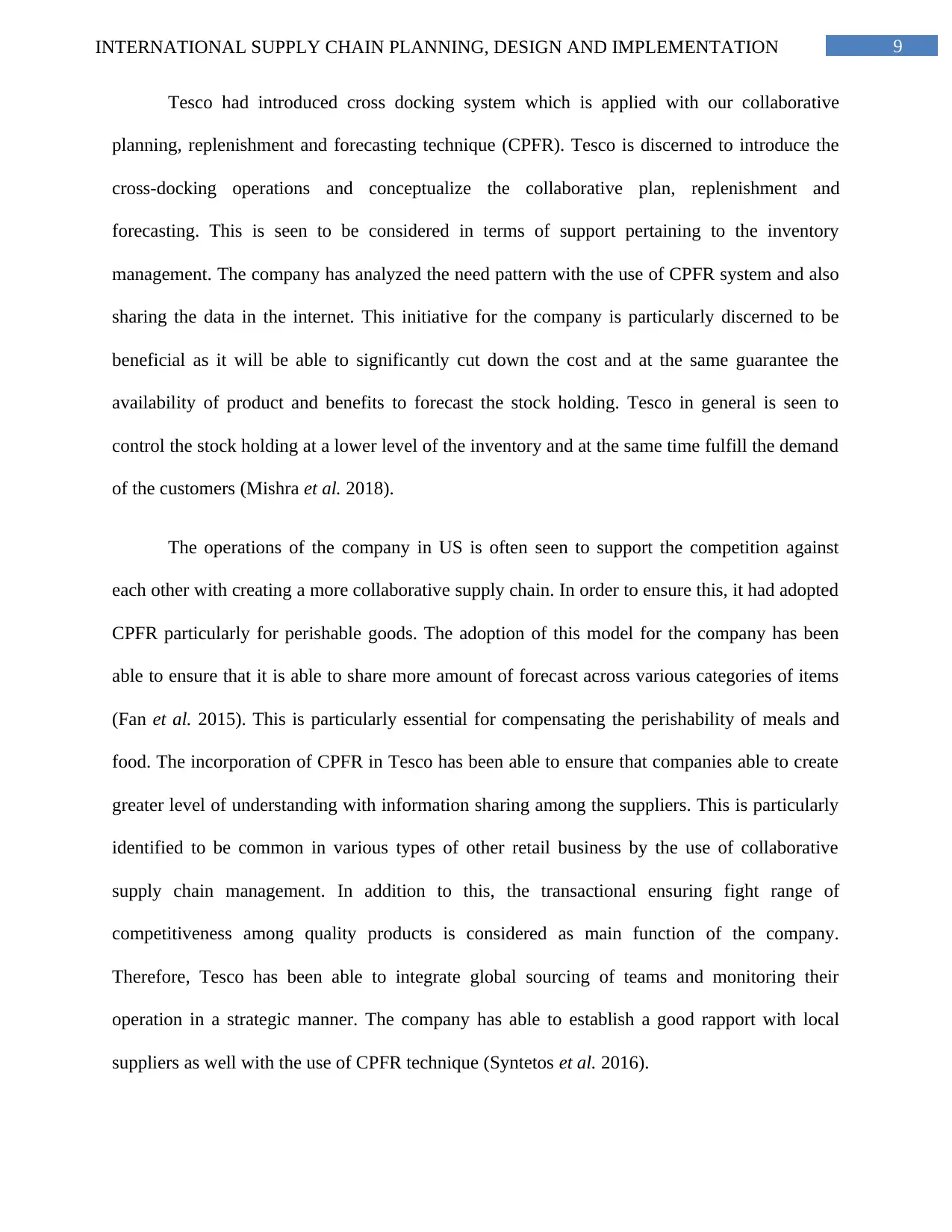
9INTERNATIONAL SUPPLY CHAIN PLANNING, DESIGN AND IMPLEMENTATION
Tesco had introduced cross docking system which is applied with our collaborative
planning, replenishment and forecasting technique (CPFR). Tesco is discerned to introduce the
cross-docking operations and conceptualize the collaborative plan, replenishment and
forecasting. This is seen to be considered in terms of support pertaining to the inventory
management. The company has analyzed the need pattern with the use of CPFR system and also
sharing the data in the internet. This initiative for the company is particularly discerned to be
beneficial as it will be able to significantly cut down the cost and at the same guarantee the
availability of product and benefits to forecast the stock holding. Tesco in general is seen to
control the stock holding at a lower level of the inventory and at the same time fulfill the demand
of the customers (Mishra et al. 2018).
The operations of the company in US is often seen to support the competition against
each other with creating a more collaborative supply chain. In order to ensure this, it had adopted
CPFR particularly for perishable goods. The adoption of this model for the company has been
able to ensure that it is able to share more amount of forecast across various categories of items
(Fan et al. 2015). This is particularly essential for compensating the perishability of meals and
food. The incorporation of CPFR in Tesco has been able to ensure that companies able to create
greater level of understanding with information sharing among the suppliers. This is particularly
identified to be common in various types of other retail business by the use of collaborative
supply chain management. In addition to this, the transactional ensuring fight range of
competitiveness among quality products is considered as main function of the company.
Therefore, Tesco has been able to integrate global sourcing of teams and monitoring their
operation in a strategic manner. The company has able to establish a good rapport with local
suppliers as well with the use of CPFR technique (Syntetos et al. 2016).
Tesco had introduced cross docking system which is applied with our collaborative
planning, replenishment and forecasting technique (CPFR). Tesco is discerned to introduce the
cross-docking operations and conceptualize the collaborative plan, replenishment and
forecasting. This is seen to be considered in terms of support pertaining to the inventory
management. The company has analyzed the need pattern with the use of CPFR system and also
sharing the data in the internet. This initiative for the company is particularly discerned to be
beneficial as it will be able to significantly cut down the cost and at the same guarantee the
availability of product and benefits to forecast the stock holding. Tesco in general is seen to
control the stock holding at a lower level of the inventory and at the same time fulfill the demand
of the customers (Mishra et al. 2018).
The operations of the company in US is often seen to support the competition against
each other with creating a more collaborative supply chain. In order to ensure this, it had adopted
CPFR particularly for perishable goods. The adoption of this model for the company has been
able to ensure that it is able to share more amount of forecast across various categories of items
(Fan et al. 2015). This is particularly essential for compensating the perishability of meals and
food. The incorporation of CPFR in Tesco has been able to ensure that companies able to create
greater level of understanding with information sharing among the suppliers. This is particularly
identified to be common in various types of other retail business by the use of collaborative
supply chain management. In addition to this, the transactional ensuring fight range of
competitiveness among quality products is considered as main function of the company.
Therefore, Tesco has been able to integrate global sourcing of teams and monitoring their
operation in a strategic manner. The company has able to establish a good rapport with local
suppliers as well with the use of CPFR technique (Syntetos et al. 2016).
Paraphrase This Document
Need a fresh take? Get an instant paraphrase of this document with our AI Paraphraser
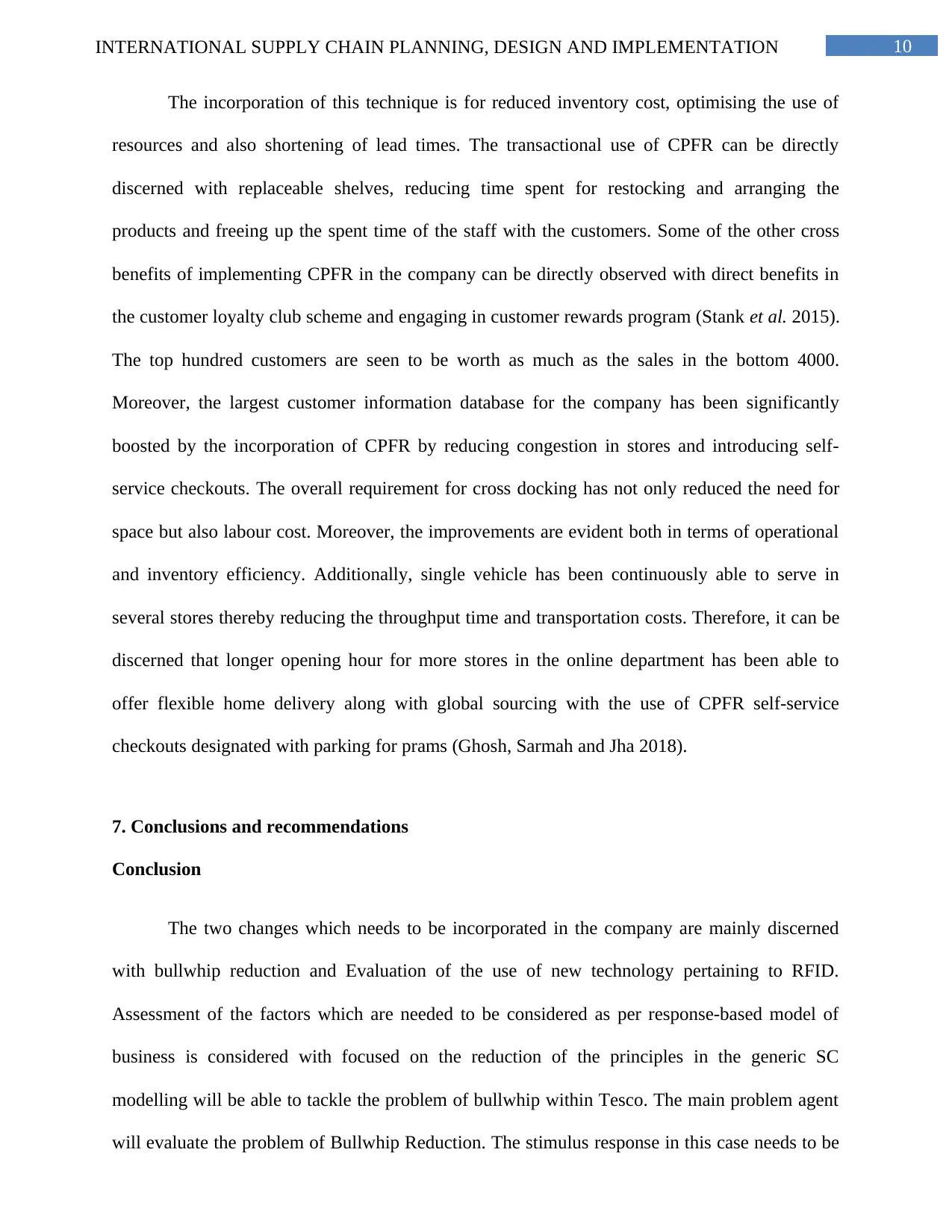
10INTERNATIONAL SUPPLY CHAIN PLANNING, DESIGN AND IMPLEMENTATION
The incorporation of this technique is for reduced inventory cost, optimising the use of
resources and also shortening of lead times. The transactional use of CPFR can be directly
discerned with replaceable shelves, reducing time spent for restocking and arranging the
products and freeing up the spent time of the staff with the customers. Some of the other cross
benefits of implementing CPFR in the company can be directly observed with direct benefits in
the customer loyalty club scheme and engaging in customer rewards program (Stank et al. 2015).
The top hundred customers are seen to be worth as much as the sales in the bottom 4000.
Moreover, the largest customer information database for the company has been significantly
boosted by the incorporation of CPFR by reducing congestion in stores and introducing self-
service checkouts. The overall requirement for cross docking has not only reduced the need for
space but also labour cost. Moreover, the improvements are evident both in terms of operational
and inventory efficiency. Additionally, single vehicle has been continuously able to serve in
several stores thereby reducing the throughput time and transportation costs. Therefore, it can be
discerned that longer opening hour for more stores in the online department has been able to
offer flexible home delivery along with global sourcing with the use of CPFR self-service
checkouts designated with parking for prams (Ghosh, Sarmah and Jha 2018).
7. Conclusions and recommendations
Conclusion
The two changes which needs to be incorporated in the company are mainly discerned
with bullwhip reduction and Evaluation of the use of new technology pertaining to RFID.
Assessment of the factors which are needed to be considered as per response-based model of
business is considered with focused on the reduction of the principles in the generic SC
modelling will be able to tackle the problem of bullwhip within Tesco. The main problem agent
will evaluate the problem of Bullwhip Reduction. The stimulus response in this case needs to be
The incorporation of this technique is for reduced inventory cost, optimising the use of
resources and also shortening of lead times. The transactional use of CPFR can be directly
discerned with replaceable shelves, reducing time spent for restocking and arranging the
products and freeing up the spent time of the staff with the customers. Some of the other cross
benefits of implementing CPFR in the company can be directly observed with direct benefits in
the customer loyalty club scheme and engaging in customer rewards program (Stank et al. 2015).
The top hundred customers are seen to be worth as much as the sales in the bottom 4000.
Moreover, the largest customer information database for the company has been significantly
boosted by the incorporation of CPFR by reducing congestion in stores and introducing self-
service checkouts. The overall requirement for cross docking has not only reduced the need for
space but also labour cost. Moreover, the improvements are evident both in terms of operational
and inventory efficiency. Additionally, single vehicle has been continuously able to serve in
several stores thereby reducing the throughput time and transportation costs. Therefore, it can be
discerned that longer opening hour for more stores in the online department has been able to
offer flexible home delivery along with global sourcing with the use of CPFR self-service
checkouts designated with parking for prams (Ghosh, Sarmah and Jha 2018).
7. Conclusions and recommendations
Conclusion
The two changes which needs to be incorporated in the company are mainly discerned
with bullwhip reduction and Evaluation of the use of new technology pertaining to RFID.
Assessment of the factors which are needed to be considered as per response-based model of
business is considered with focused on the reduction of the principles in the generic SC
modelling will be able to tackle the problem of bullwhip within Tesco. The main problem agent
will evaluate the problem of Bullwhip Reduction. The stimulus response in this case needs to be
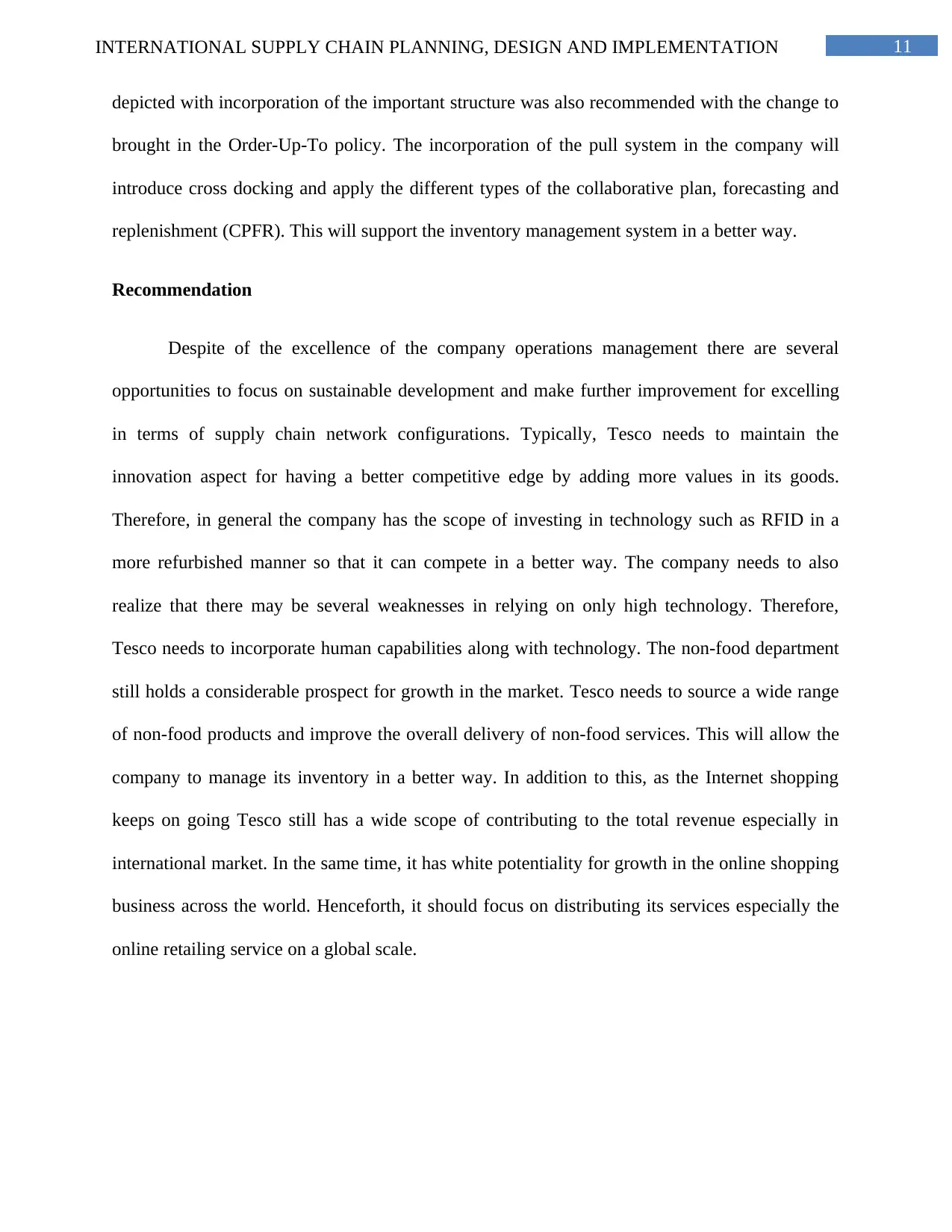
11INTERNATIONAL SUPPLY CHAIN PLANNING, DESIGN AND IMPLEMENTATION
depicted with incorporation of the important structure was also recommended with the change to
brought in the Order-Up-To policy. The incorporation of the pull system in the company will
introduce cross docking and apply the different types of the collaborative plan, forecasting and
replenishment (CPFR). This will support the inventory management system in a better way.
Recommendation
Despite of the excellence of the company operations management there are several
opportunities to focus on sustainable development and make further improvement for excelling
in terms of supply chain network configurations. Typically, Tesco needs to maintain the
innovation aspect for having a better competitive edge by adding more values in its goods.
Therefore, in general the company has the scope of investing in technology such as RFID in a
more refurbished manner so that it can compete in a better way. The company needs to also
realize that there may be several weaknesses in relying on only high technology. Therefore,
Tesco needs to incorporate human capabilities along with technology. The non-food department
still holds a considerable prospect for growth in the market. Tesco needs to source a wide range
of non-food products and improve the overall delivery of non-food services. This will allow the
company to manage its inventory in a better way. In addition to this, as the Internet shopping
keeps on going Tesco still has a wide scope of contributing to the total revenue especially in
international market. In the same time, it has white potentiality for growth in the online shopping
business across the world. Henceforth, it should focus on distributing its services especially the
online retailing service on a global scale.
depicted with incorporation of the important structure was also recommended with the change to
brought in the Order-Up-To policy. The incorporation of the pull system in the company will
introduce cross docking and apply the different types of the collaborative plan, forecasting and
replenishment (CPFR). This will support the inventory management system in a better way.
Recommendation
Despite of the excellence of the company operations management there are several
opportunities to focus on sustainable development and make further improvement for excelling
in terms of supply chain network configurations. Typically, Tesco needs to maintain the
innovation aspect for having a better competitive edge by adding more values in its goods.
Therefore, in general the company has the scope of investing in technology such as RFID in a
more refurbished manner so that it can compete in a better way. The company needs to also
realize that there may be several weaknesses in relying on only high technology. Therefore,
Tesco needs to incorporate human capabilities along with technology. The non-food department
still holds a considerable prospect for growth in the market. Tesco needs to source a wide range
of non-food products and improve the overall delivery of non-food services. This will allow the
company to manage its inventory in a better way. In addition to this, as the Internet shopping
keeps on going Tesco still has a wide scope of contributing to the total revenue especially in
international market. In the same time, it has white potentiality for growth in the online shopping
business across the world. Henceforth, it should focus on distributing its services especially the
online retailing service on a global scale.
⊘ This is a preview!⊘
Do you want full access?
Subscribe today to unlock all pages.

Trusted by 1+ million students worldwide
1 out of 26
Related Documents
Your All-in-One AI-Powered Toolkit for Academic Success.
+13062052269
info@desklib.com
Available 24*7 on WhatsApp / Email
![[object Object]](/_next/static/media/star-bottom.7253800d.svg)
Unlock your academic potential
Copyright © 2020–2025 A2Z Services. All Rights Reserved. Developed and managed by ZUCOL.





